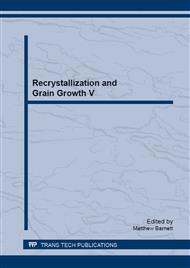p.217
p.221
p.225
p.231
p.235
p.239
p.243
p.247
p.251
Recovery Kinetics in High Purity and Commercial Purity Aluminium Alloys
Abstract:
Motivated by improving current softening models for recycle friendly alloys, softening was investigated in high purity and commercial purity aluminium alloys. Utilizing the electron backscatter diffraction (EBSD) technique, orientation dependent sub-grain growth was characterized with respect to grain size and average boundary misorientation. In the high purity alloys, small additions of Mn in solid solution slowed down the recovery kinetics. The recovery mechanisms were however not altered, but recovery kinetics were found to be orientation dependent. The presence of high angle grain boundaries or transition bands, i.e. large and sharp orientation gradients, seemed to change the growth from slow and continuous to a faster and discontinuous process. This was typical for Cube and Goss, while weak, short and long range orientations gradients observed in Copper, S and Brass, did not alter growth which was slow and continuous. Before detailed studies of recovery of the commercial purity alloy were initiated, a rather slow recovery was observed and further investigated. Preliminary results indicate that iron in solid solution is dramatically slowing down the kinetics but can form clusters by an intermediate annealing in order to speed up recovery.
Info:
Periodical:
Pages:
235-238
Citation:
Online since:
March 2013
Authors:
Keywords:
Price:
Сopyright:
© 2013 Trans Tech Publications Ltd. All Rights Reserved
Share:
Citation:


